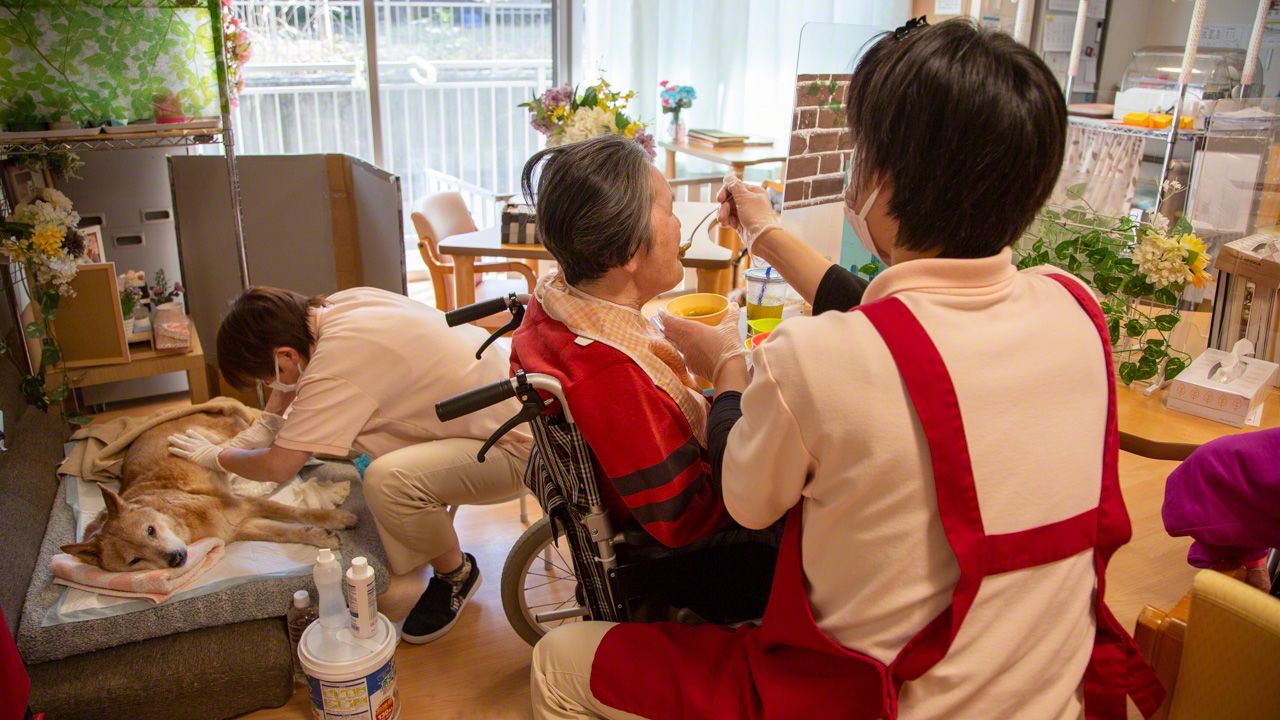
Confronting the Years: A Photographer’s Tour of Japan’s Hyper-Aging Society
A Home Where Old People Can Live Together with Their Pets
Society Health- English
- 日本語
- 简体字
- 繁體字
- Français
- Español
- العربية
- Русский
Humans and Their Pets, Growing Old Together
I share my life with the family dog, a male shiba-inu we call Ikkyū. As his name suggests, Ikkyū (meaning a rest or break) brings moments of peace and tranquility to these late afternoon years of my life. The touch of his wet nose against my hand when I wake in the mornings is enough to fill me with the joy of being alive. Ikkyū is 15 now, though, and over the past year or so he has suddenly started to show his age. He’s no longer as steady on his feet as he used to be. He has started to lose bladder control and sometimes yowls for no obvious reason, showing signs of what may be a canine version of dementia. I always imagined we’d be together till the end. Now, I can no longer be sure. I can’t bear to contemplate being separated. I think I’d lose my mind.
Rapid aging is not something that affects only human societies. Our pets are getting older too. How can we make it possible for humans and their animal companions to comfort and look after each other in their twilight years, even if the human partner has to move into a care facility? One place making pioneering efforts to address this question is Sakura no Sato Yamashina, a nursing home for the elderly in Yokosuka, Kanagawa Prefecture.
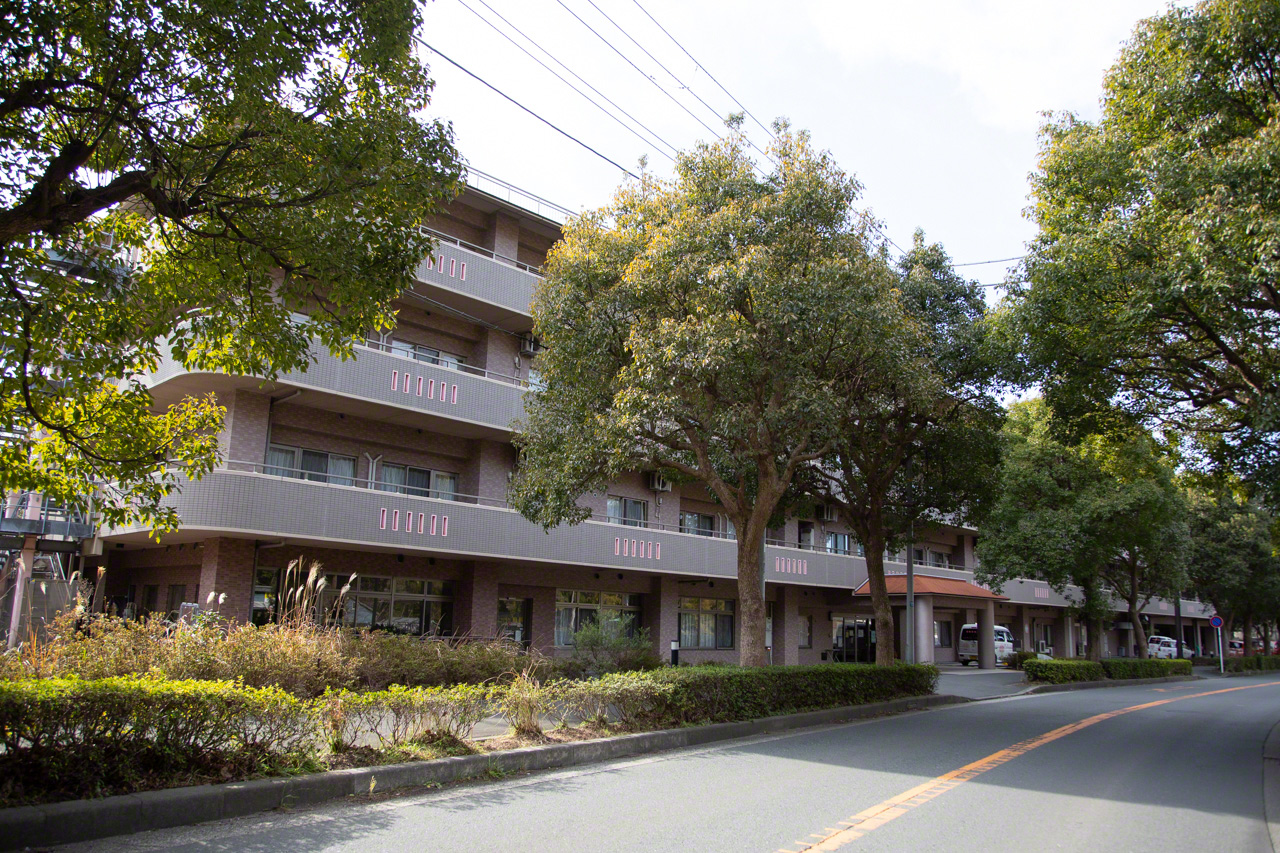
Sakura no Sato Yamashina: a “Cherry Blossom Village” of sunlight, breezes, and abundant greenery. (© Ōnishi Naruaki)
The facility was built in 2012 and has 100 beds in private rooms set across four stories. These include two special units, each one made up of 10 rooms, where residents live together with their cats and dogs.
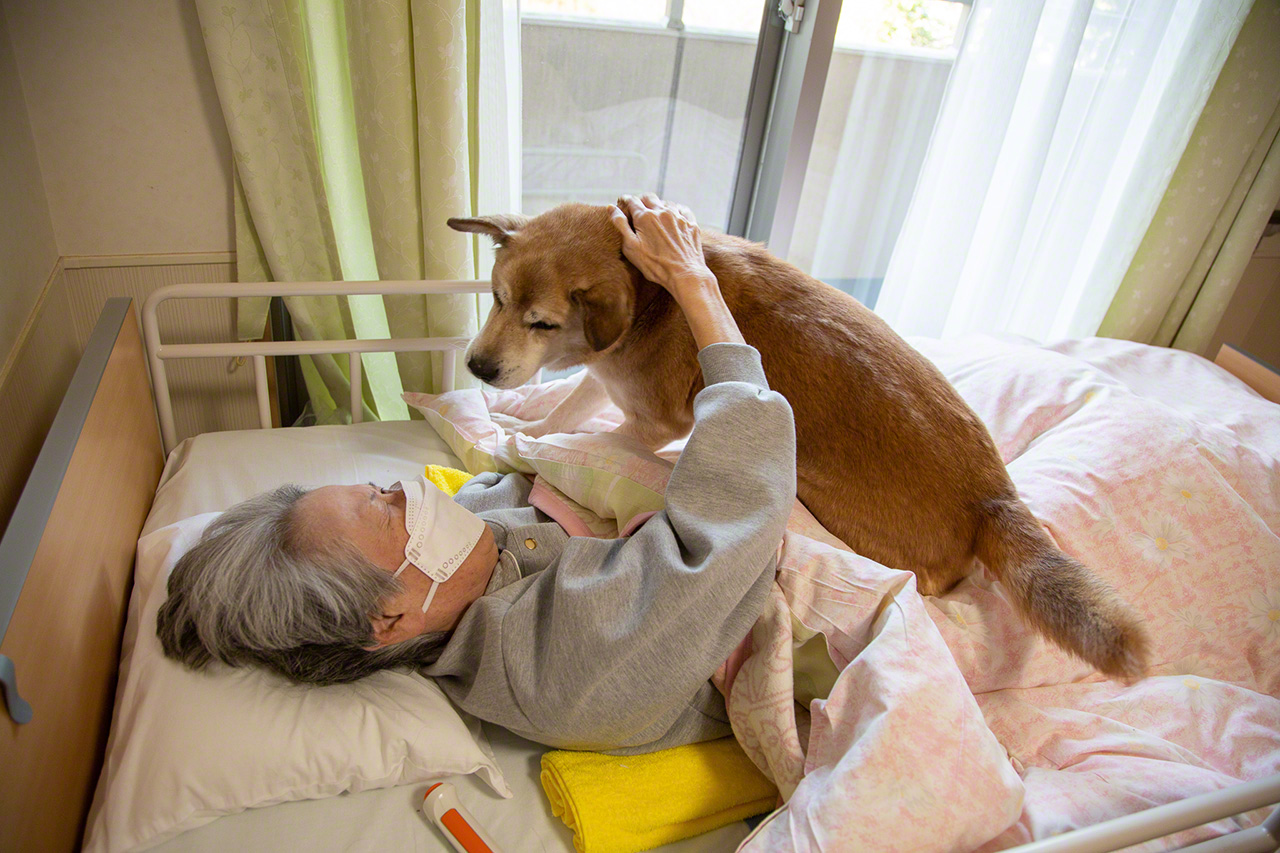
Care dog Bunpuku gives a warm welcome to a resident who has just moved into the facility. (© Ōnishi Naruaki)
The units welcome residents who have animals at home they want to bring with them, as well as others who perhaps had dogs or cats in the past and want to share their lives with pets again after entering full-time care. The facility takes in rescued dogs and cats from shelters, giving them a place to live and putting them to work in the care of the elderly residents.
The phrase “companion animal welfare” still has an unfamiliar ring to it. The idea is to provide care to humans and their pets alike—treating the dogs and cats as part of a community together with their human owners. The director of the Sakura no Sato facility, Wakayama Michihiko, describes it as a groundbreaking new model for care for the elderly and people with disabilities.
Sharing Moments of Kindness and Happiness
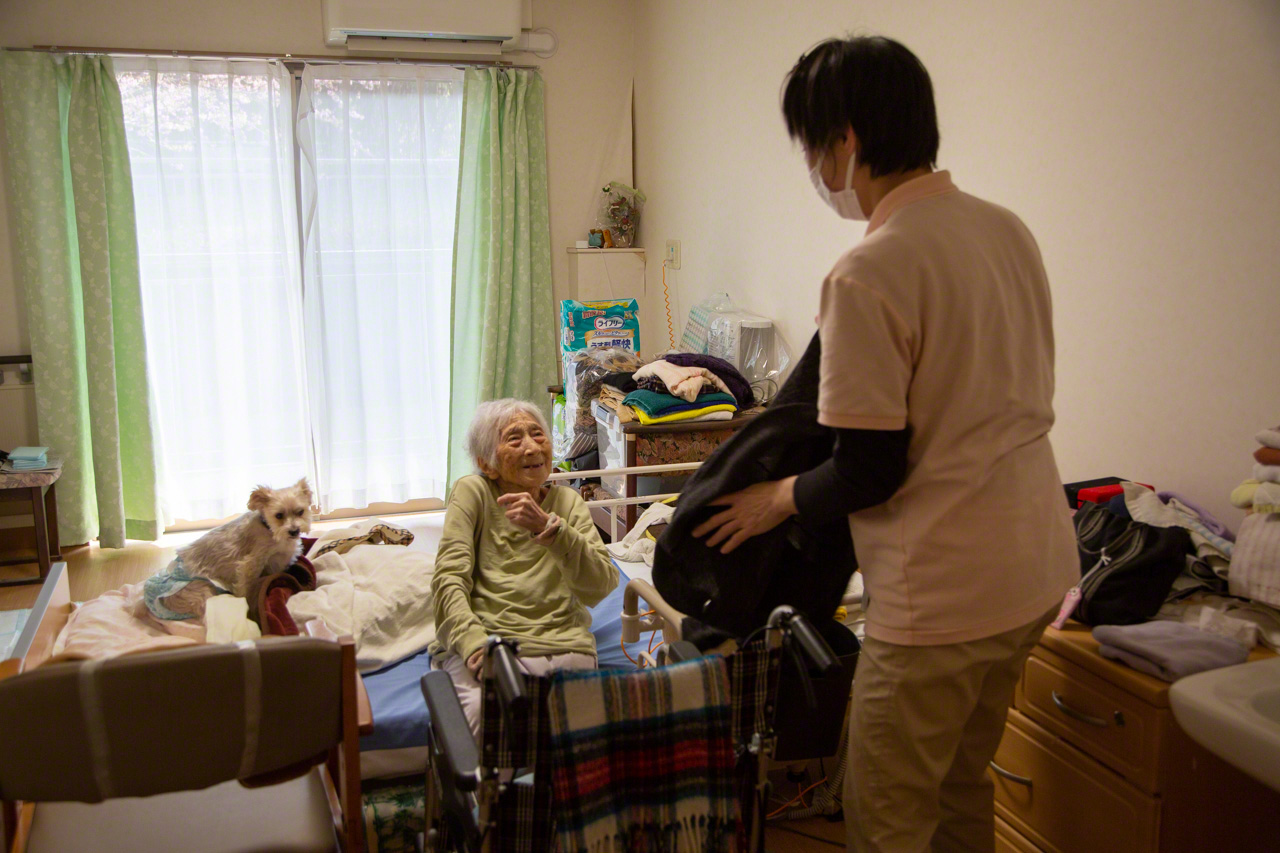
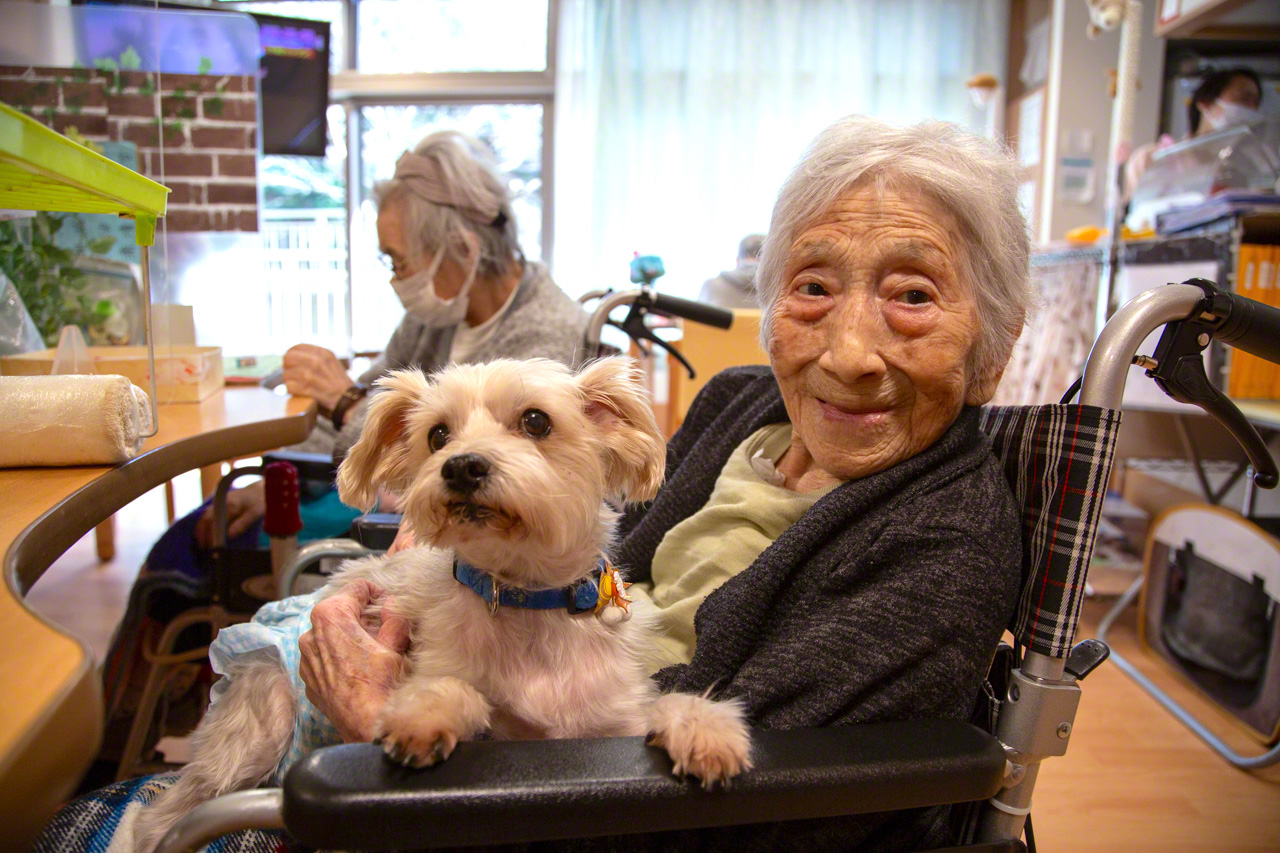
Ms. Nozawa, a 97-year-old resident, enjoys a quiet moment with her dog Mick as care staff look after the day’s tasks. (© Ōnishi Naruaki)
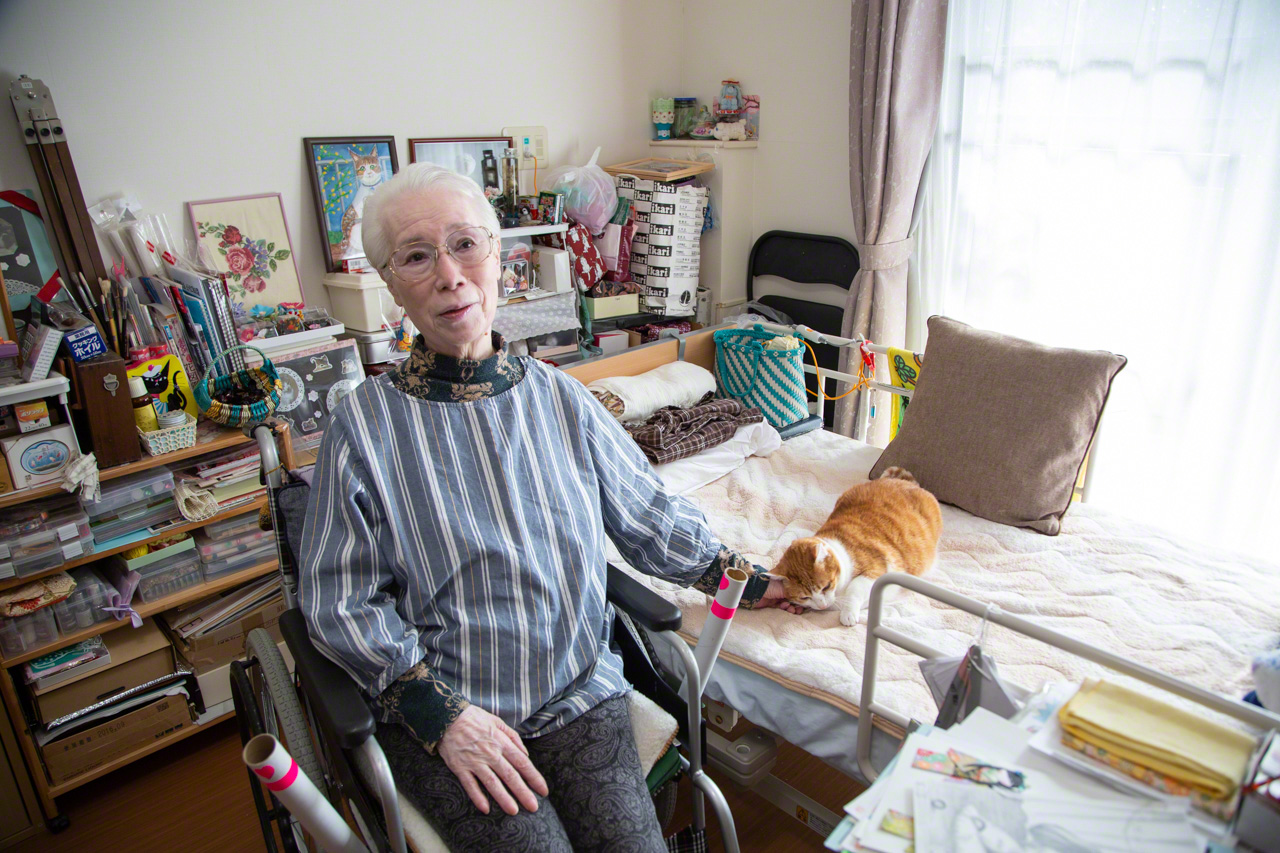
Ms. Sawada (79) moved into the home with a cat of her own, who died three years ago. Yurikko, one of the resident “care cats,” often comes to visit during breaks. (© Ōnishi Naruaki)
Schoolteacher Turned Caregiver
After graduate school, Wakayama took a job as a teacher in Ibaraki Prefecture, working at a high school known for getting students into selective universities. He was in his eighth year in the job when his parents announced their plans to start a care facility. Until then, it had been an ordinary family—his father a company employee and his mother a housewife—and as they excitedly made plans for this sudden career change, they told Wakayama they wanted him to help. At first, he wasn’t interested—he was enjoying teaching and found the work rewarding. That changed when one of his students, a bright and active girl with dreams of becoming a scientist, was killed in a traffic accident while cycling to school one day. Having coached her classmates through the trauma and navigated them successfully through their college entrance exams, Wakayama made up his mind to follow his parents into their new career. In 1999, the family founded Kokoro no Kai, a social welfare corporation, and the following year opened a daycare service for elderly people and an assistance facility that helped people with learning disabilities to find work.
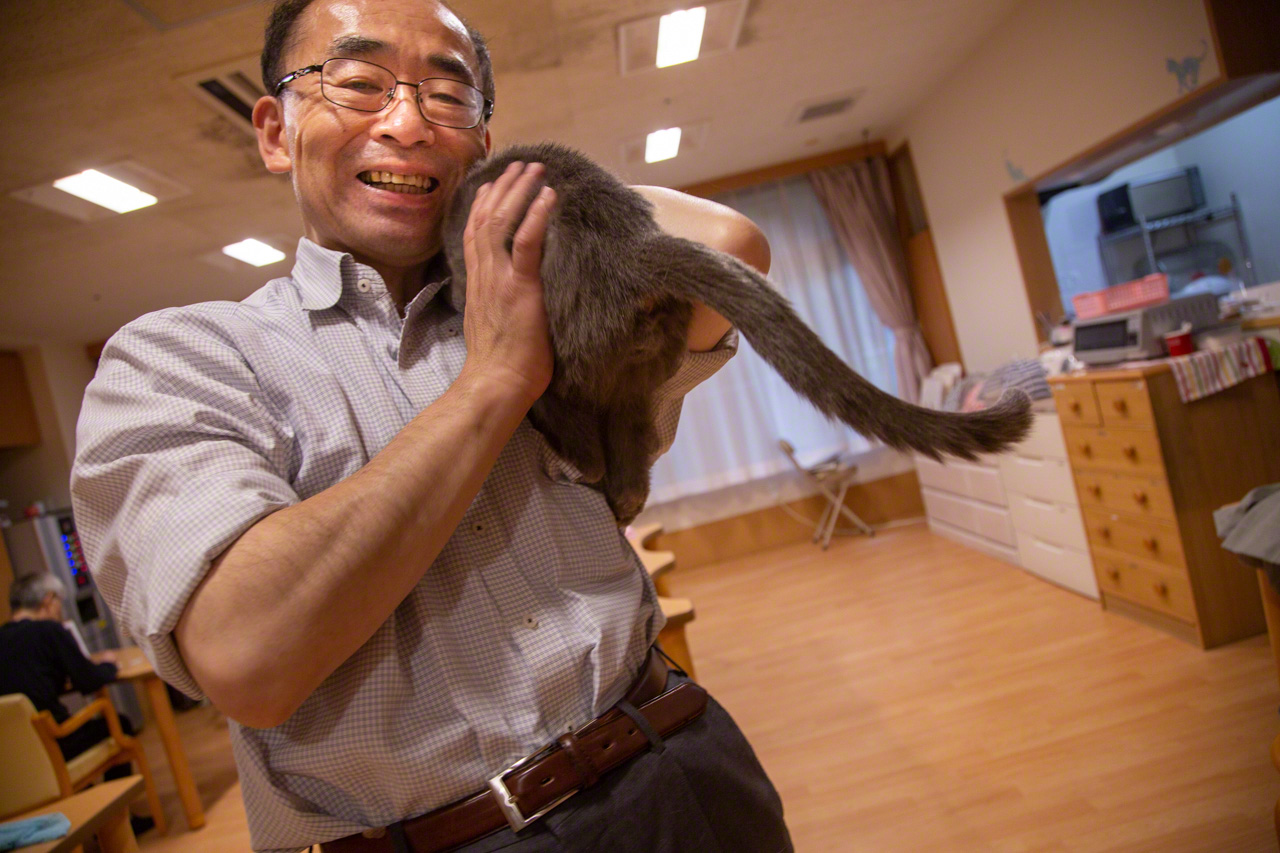
Wakayama lifts up Aoi, a Russian Blue that is one of the care cats kept at the facility. (© Ōnishi Naruaki)
Making Things Possible
Professional caregivers often talk about providing care that “never gives up.” Wakayama was determined that this should be more than just a phrase, and wanted to do whatever he could to make it a reality. This became the inspiration for the model of care he wanted to provide at the new facility.
Around that time, he heard of an elderly man who had been forced to hand over his beloved dog for euthanasia in order to move into an old people’s home. The man had never forgiven himself, and tearfully spoke of having “killed a member of the family with my own hands.” He died six months later. Wakayama was horrified. How could it be considered acceptable to inflict such suffering and misery on a person at the end of his life? He started to consider the possibly of a residential care home that would allow residents to bring their pets with them.
Not long after Sakura no Sato Yamashina opened, the facility admitted a man who had been living with his dog while receiving public support at home. Despite advancing dementia symptoms, he refused to move into a care facility if it meant being separated from his dog, and this had caused considerable headaches for the local authorities. Eventually it was arranged that he would move into Sakura, where he spent his remaining days with his beloved companion. The man eventually died peacefully at the home, six months after his dog.
Bunpuku, the “Miracle Dog” Who Watches Over the Dying
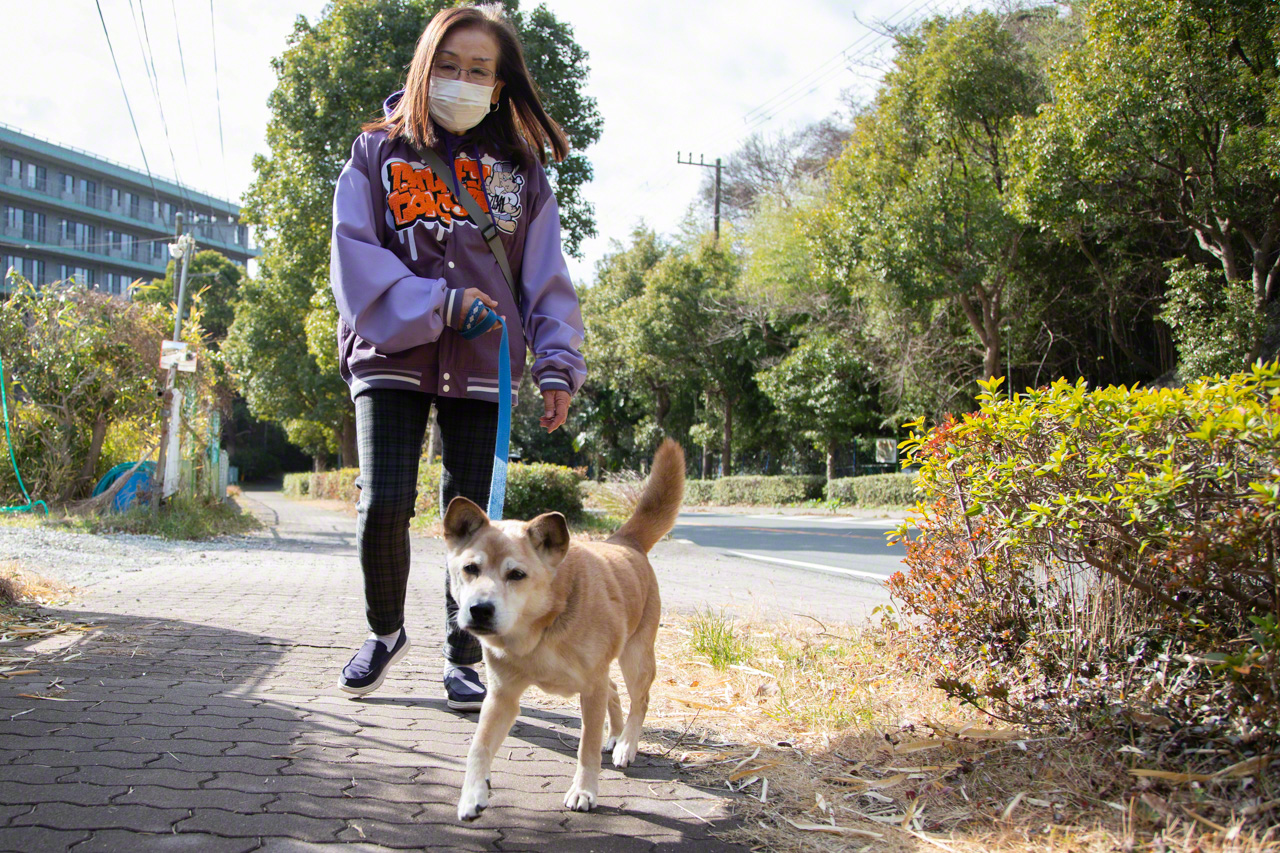
Bunpuku sets out enthusiastically on a walk with a volunteer. (© Ōnishi Naruaki)
One of the most popular residents at the home is Bunpuku, a Shiba mix thought to be around 15 years old.
Bunpuku seems to have an uncanny ability to sense the approach of death. Perhaps it’s something to do with the canine sense of smell. His supernatural senses became known when staff noticed him taking up a vigil in front of a particular resident’s room. A few days later, the person died. When he sensed a premonition that the end was near, Bunpuku jumped onto the bed and licked the person’s face tenderly, as if unwilling to let go. This behavior was repeated several times in the years that followed. Wakayama is convinced that it was driven by a desire to bring comfort to residents in their final moments. The behavior has waned in recent years, perhaps because Bunpuku’s sense of smell has started to deteriorate with age—but in 2019, Wakayama published a book about the “miracle dog” and Bunpuku was featured prominently on television and in numerous magazine articles.
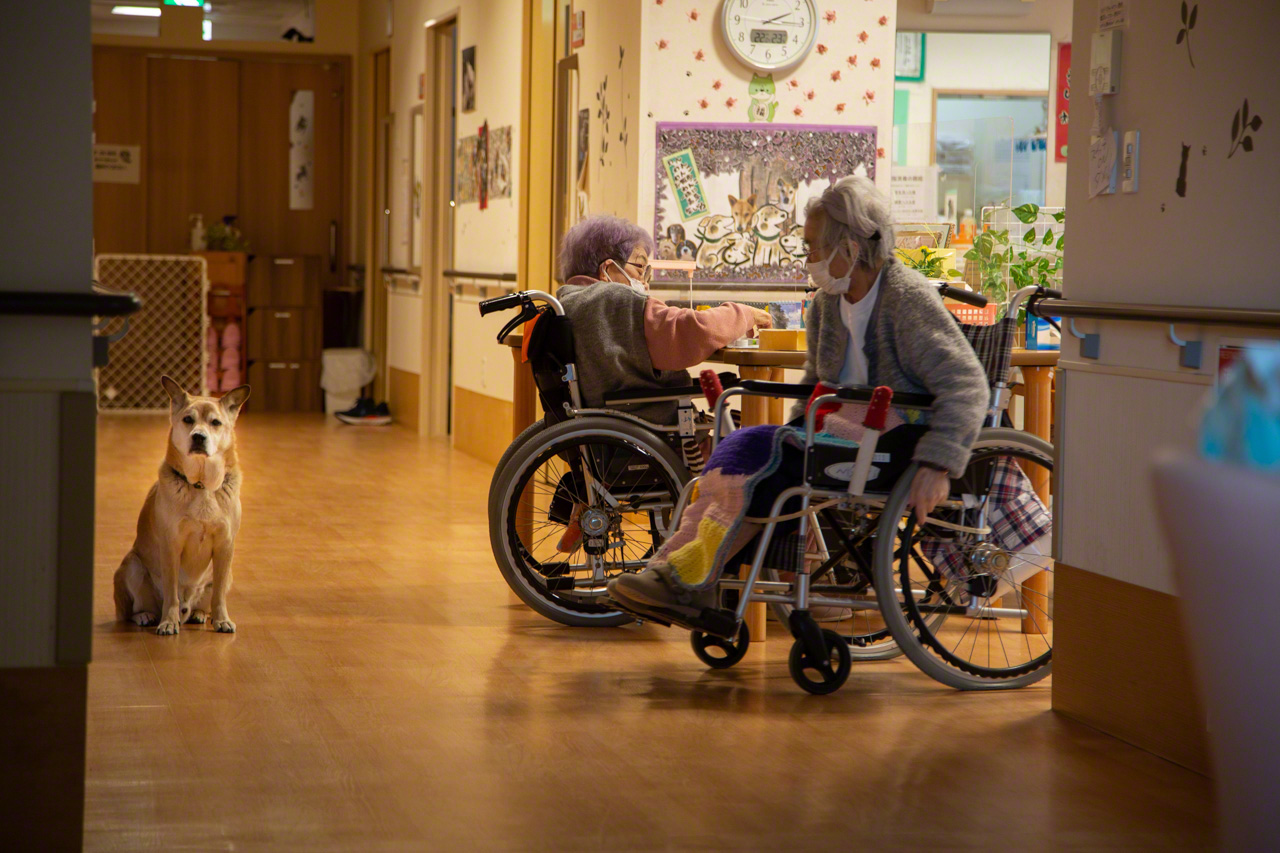
Bunpuku stands alert and ready to protect his family. (© Ōnishi Naruaki)
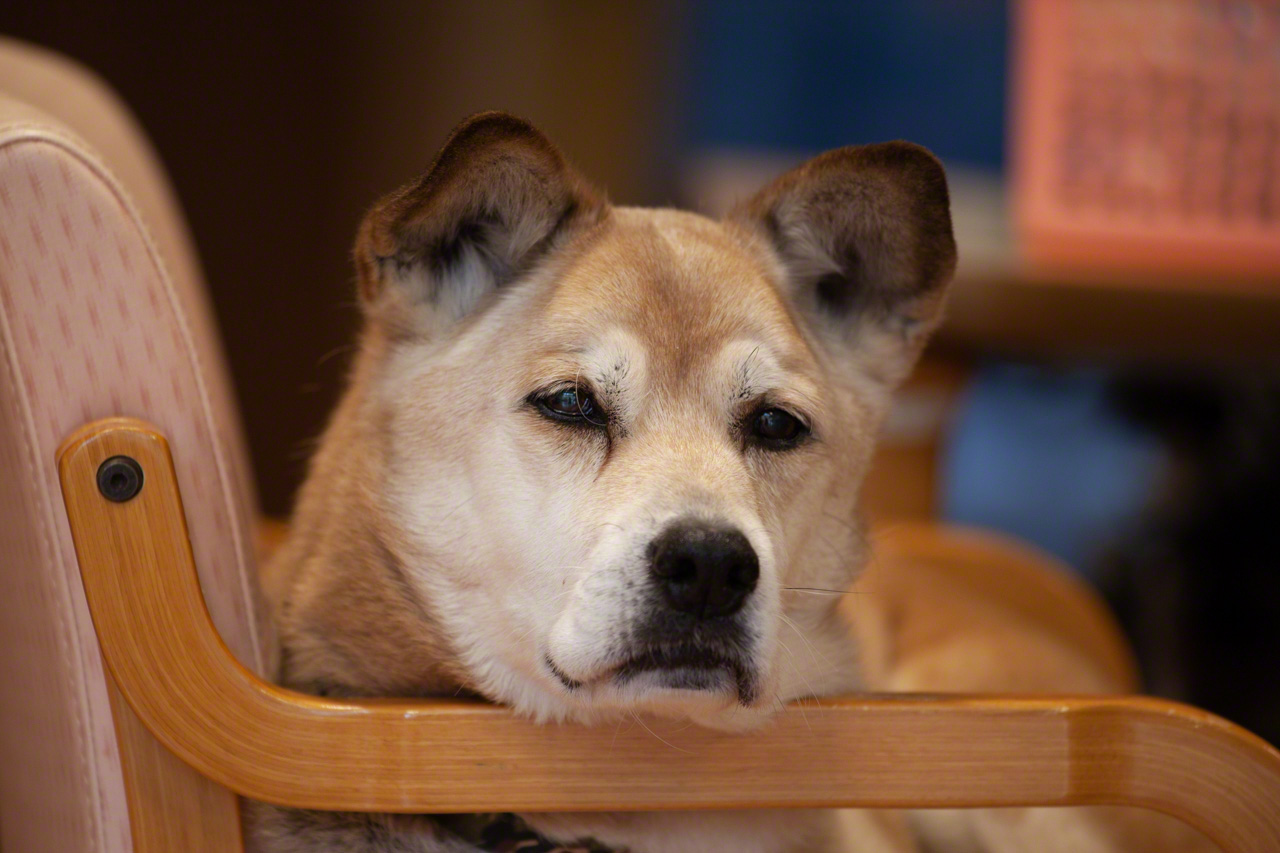
Bunpuku enjoys a snooze in his favorite chair. (© Ōnishi Naruaki)
In fact, Bunpuku had his own close brush with death before he came to the facility. He was rescued by an animal welfare group from a clinic in Chiba Prefecture just minutes before he was due to be put down. Perhaps this experience of having been tossed aside and having stood on the brink of death led to his sensitivity to its approach in his new home.
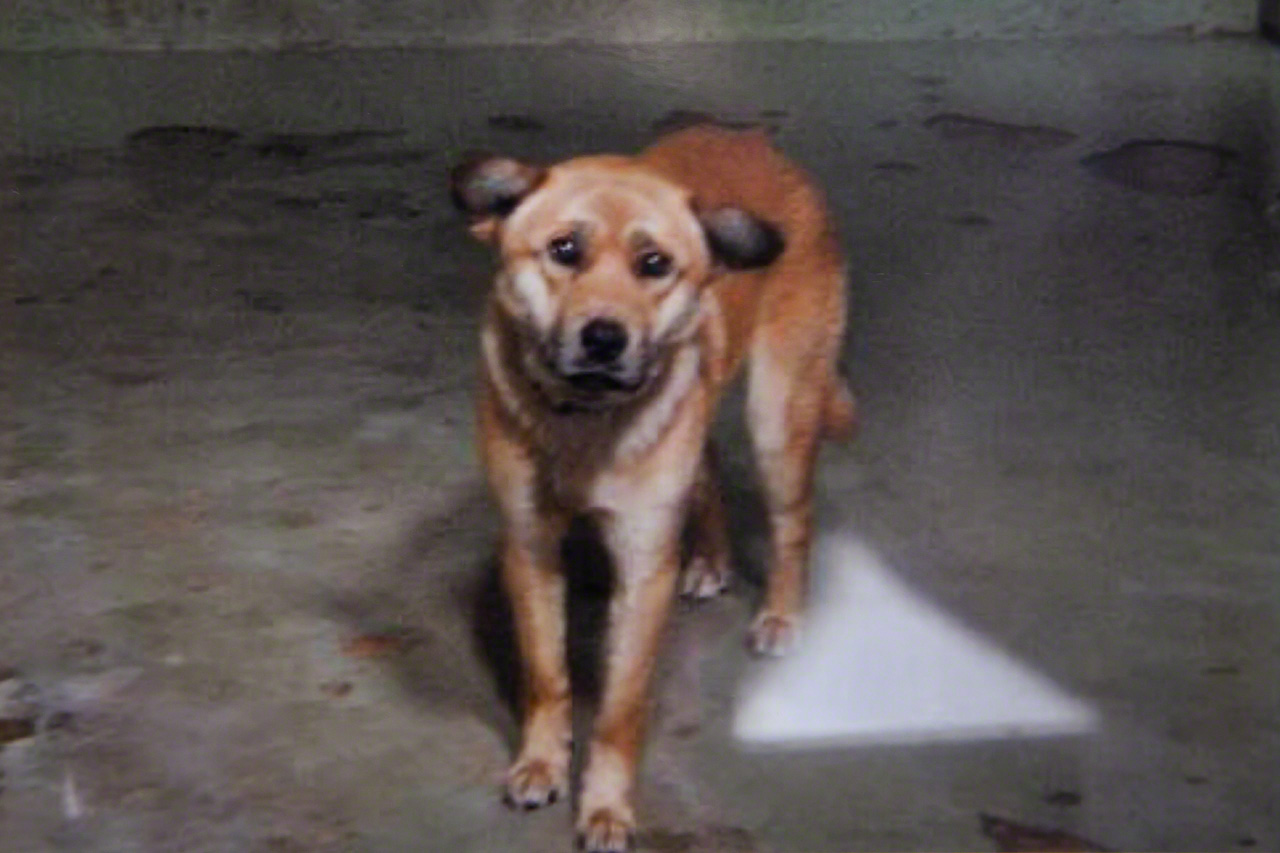
Bunpuku moments before he was scheduled to be put down, when he was 1 or 2 years old. (Courtesy of the Chiba-wan animal welfare group)
Daiki is another Shiba crossbreed who was rescued before coming to the facility. The first time I met him, he was already restricted to his bed, where he was being lovingly looked after by Izuta Keiko, one of the care providers at the facility.
Izuta has a special qualification in caring for old dogs. The devotion she was lavishing on Daiki was unmistakable. “Oh, looking after Daiki has never felt like a burden—not for a moment,” she said unhesitatingly.
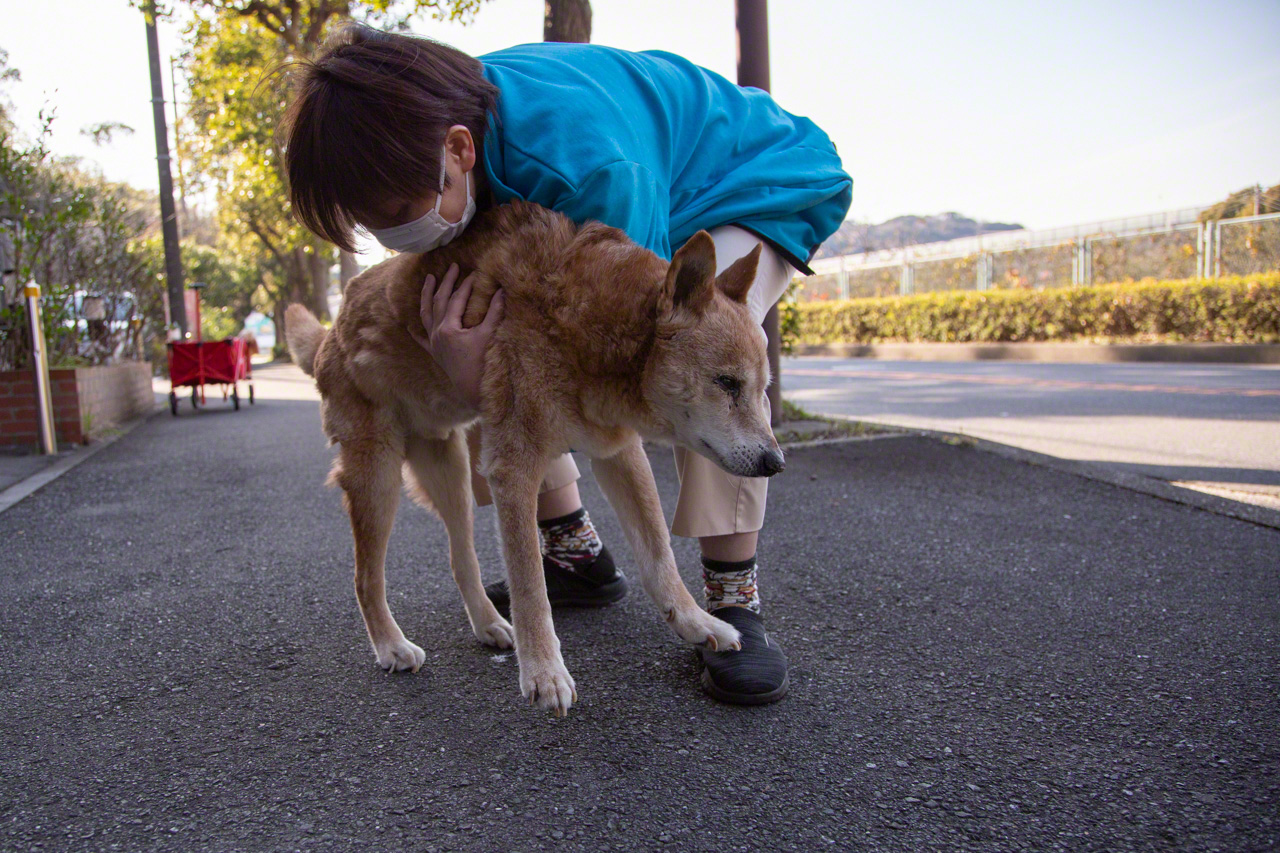
Daiki loves to feel the breeze on his back. With a helping hand from his caregiver, he summons his last reserves of strength and steadies himself to start walking. (© Ōnishi Naruaki)
Crossing the Rainbow Bridge
On March 27, 2024, Daiki died. His final moments were described on the Sakura no Sato Yamashina blog as follows:
Daiki has set off across the rainbow bridge. He left on his final journey with a peaceful expression on his face, as if he were falling asleep. Just this morning, under a clear blue sky, I saw Izuta-san carry him outside for a walk, wrapped up in her arms.
I remembered a photograph I had taken on my previous visit, of Izuta holding Daiki in her arms. Sunlight streams through the windows, and the trees outside throw patterns against the wall, flickering like a rainbow bridge in a shadow play.
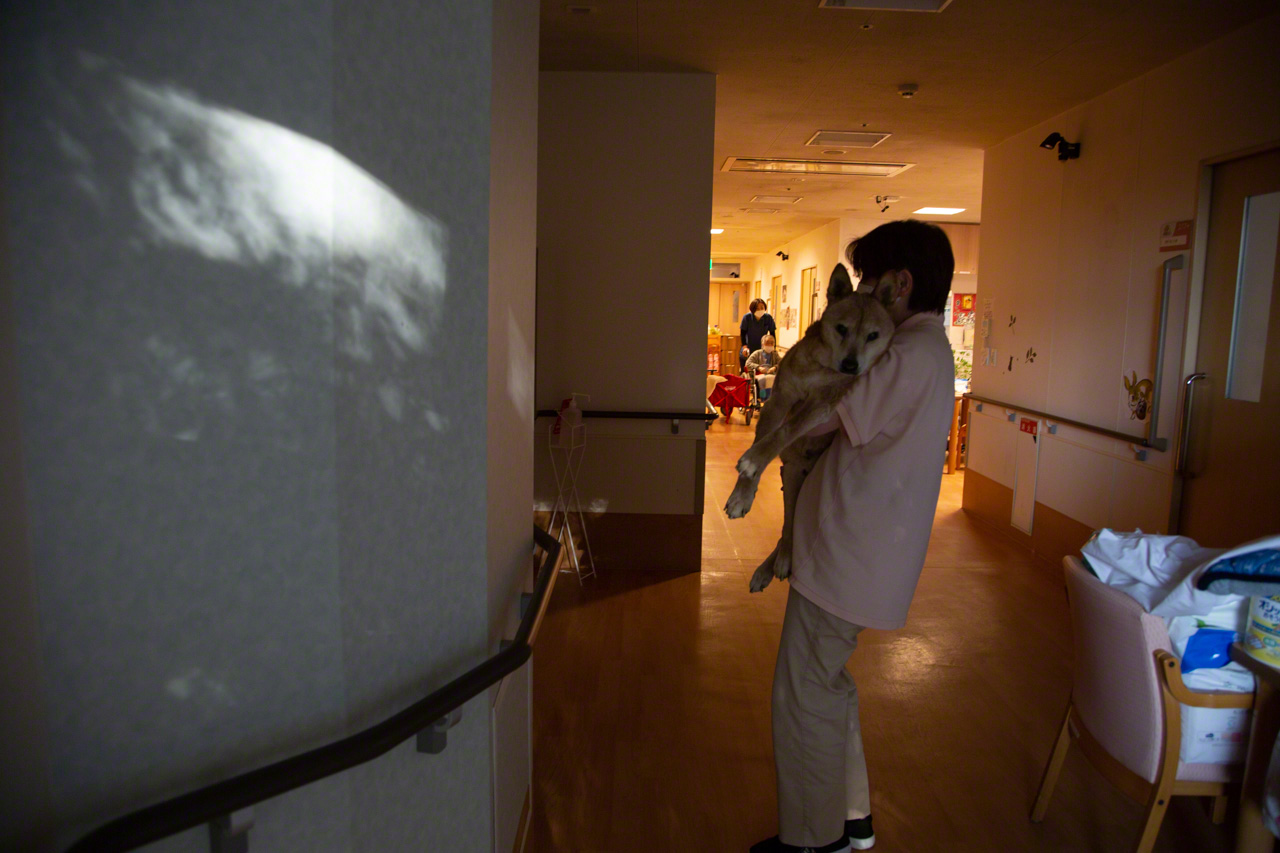
The shadows of the trees seemed to dance on the wall like a bridge to another world. (© Ōnishi Naruaki)
The Joy of Living with Pets in Old Age
No doubt many animal-lovers would like to see special care facilities like Sakura no Sato Yamashina increase in the future. But Wakayama says that although numerous people have visited the facility since it opened, as yet there are few signs of anyone else planning to establish a similar facility of their own.
And it’s true that the hurdles involved in operating a facility where elderly residents can live with their pets are considerable: The animals have to be fed, medical fees and other costs must be paid, and extra staff hired to walk the dogs. All this comes on top of hygiene requirements and red tape. In fact, though, some of these obstacles are not as daunting as they might appear. In terms of hygiene, for example, there is no need to do much more than the routine things most facilities would do anyway for their human residents. And any small inconveniences are surely outweighed by the benefits of having dogs and cats about the place. Their effect on the morale of the pet-loving staff is palpable, and the facility was filled with laughter throughout my visits. Perhaps more than anything, living with pets brings variety and energy into residents’ lives. Wakayama says he has seen for himself how the stimulation and responsibility that come from looking after animals can improve dementia symptoms and restore flexibility to arthritic joints.
Death as an Ordinary Part of Life
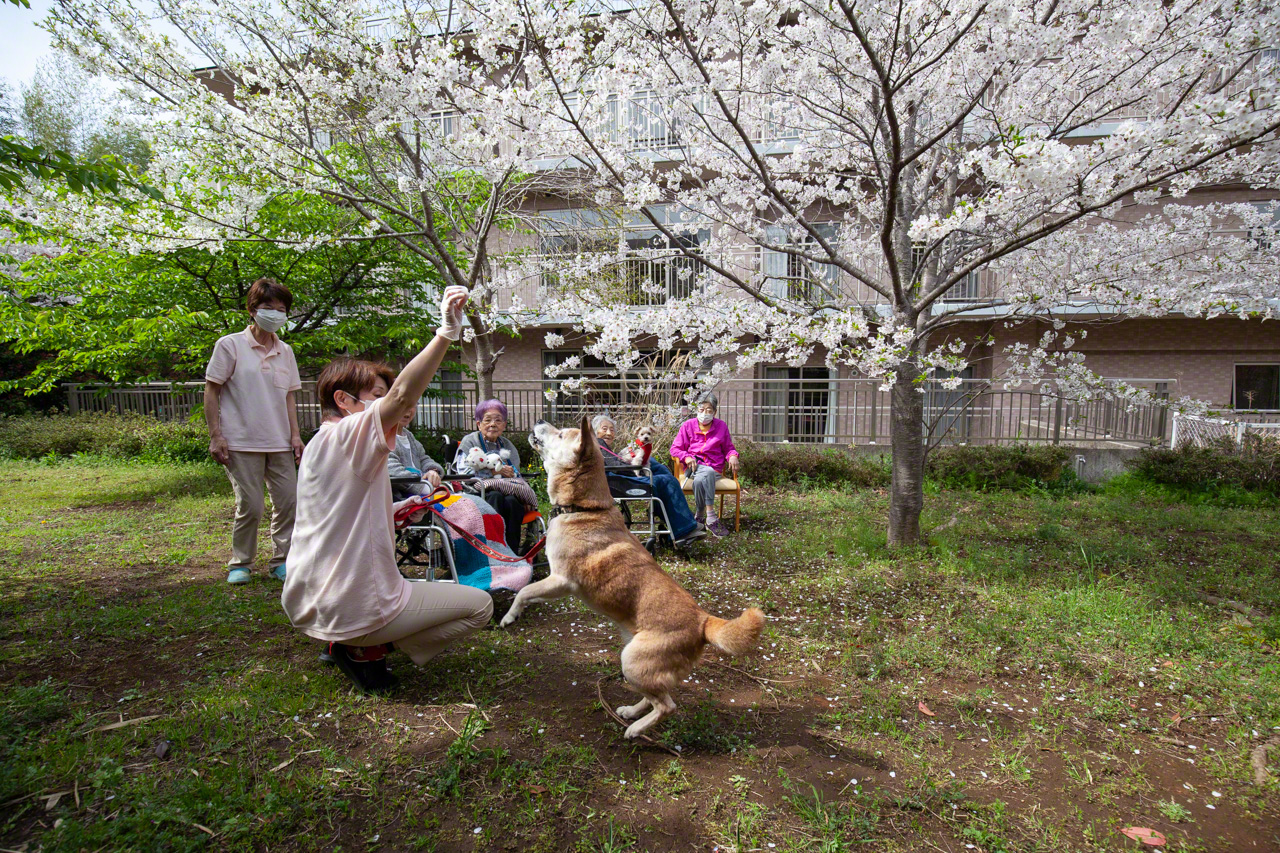
Residents enjoy the cherry blossoms in the garden just outside the facility. Bunpuku’s energy and good nature bring a smile to everyone’s face. (© Ōnishi Naruaki)
One thing I felt strongly was that the dogs and cats did not “belong” to any one person. They were treasured by the whole community. Dogs and cats that had been neglected and abandoned had been rescued from loneliness and fear of death and welcomed into a new home. And now the animals were returning the favor, bringing enjoyment and hope into the lives of the elderly residents and their caregivers.
“Death is not something out of the ordinary. It is the final act of life—something natural that comes to everyone,” Wakayama told me during one of my visits. His words resonated with me. The more I think about them, the more they seem to make perfect sense.
And as every year, the spring and its blossoms have returned once again to Sakura no Sato Yamashina.
(Originally published in Japanese. Banner photo: Sakura no Sato Yamashina, where dogs and humans share their lives and care for each other. © Ōnishi Naruaki.)

